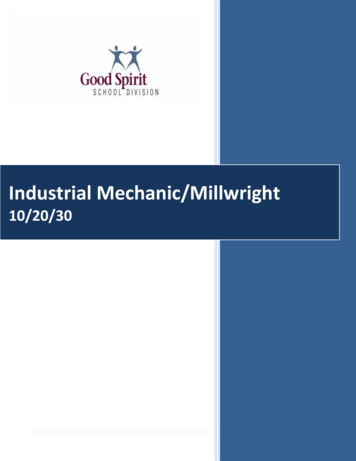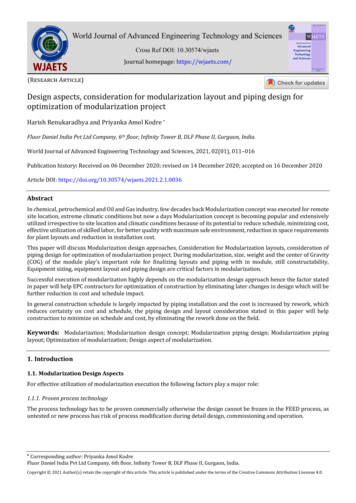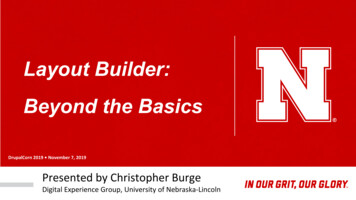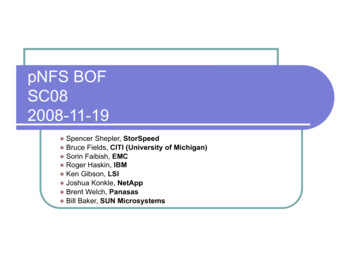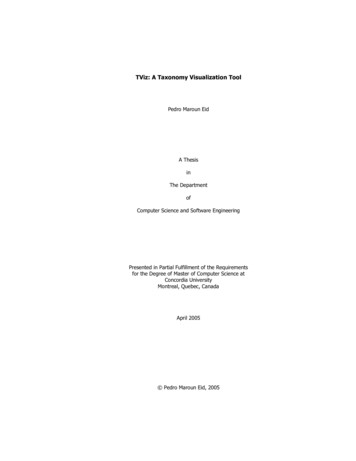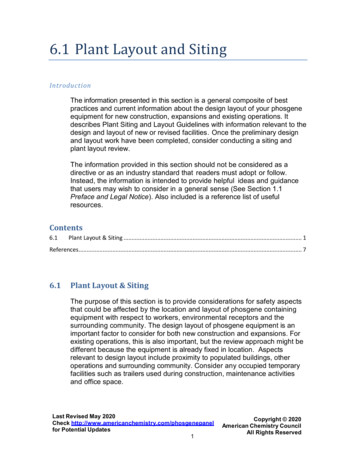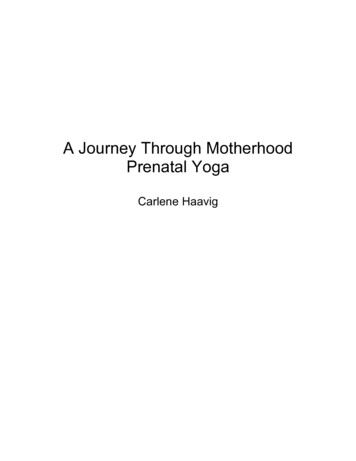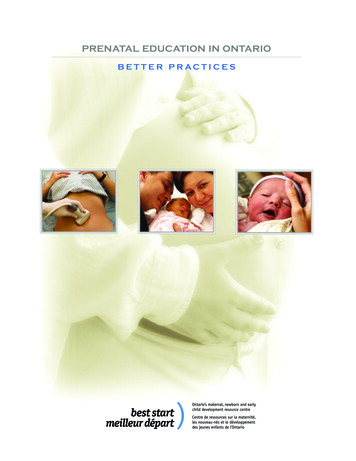
Transcription
PRENATAL EDUCATION IN ONTARIOB E T T E R P R AC T I C E S
AcknowledgementsThis Best Start Resource Centre manual was developed through the involvement of a large number of people who generouslyshared their time, expertise, suggestions and resources. The development process involved an advisory committee, keyinformants and topic experts.The Best Start Resource Centre would especially like to thank the advisory committee for helping shape the documentthrough their regular input and helpful advice. The advisory committee was comprised of representatives from public healthdepartments, private and non-profit organizations and a community health centre offering prenatal education programs.The committee was representative of French and English service providers across Ontario.The key informants and topic experts provided many of the ideas and suggestions in this manual and their knowledge wasinvaluable. Topic experts were consulted to augment the information in certain areas and we wish to thank them for sharingtheir unique expertise.Many organizations shared their curricula with us and this helped us build a comprehensive list of topics and teachingstrategies that are used in prenatal education. We wish to thank the organizations and the staff who made it all possible.While the participation of the advisory committee, key informants and topic experts was critical to the development of thisBest Start resource, final decisions about content were made by the Best Start Resource Centre.RESEARCHER/WRITERTOPIC EXPERTSLouise Choquette, Best Start Resource CentreGlynnis Dubois, Perinatal Bereavement Services of OntarioADVISORY COMMITTEEKathy Inkpen, Public Health Program Coordinator,Nova Scotia Health Promotion & ProtectionSusan Blue, Toronto Public HealthLisa Lambkin, Grey Bruce Health UnitWendy Burgoyne, Best Start Resource CentreDonna Launslager, Multiple Births CanadaVirginia Collins, Childbirth and Postpartum ProfessionalAssociation (CAPPA) CanadaLori Levere, Ontario Breastfeeding CoalitionKathy Crowe, City of Ottawa Public HealthKaren O’Gorman, Pregnancy and Health CommunityOutreach Project Thunder BayAnn Keys, Peterborough County-City Health UnitHeidi Sin, The Regional Municipality of YorkAngie Manners, Centre de santé communautairedu TémiskamingRonda Smith, Reproductive Care Program of Nova ScotiaChris Veldhoven, The 519 Church Street Community CentreAttie Sandink, Birth & Baby NeedsLyne Soramaki, Thunder Bay District Health UnitPRENATAL CURRICULA REVIEWEDKEY INFORMANTSCanada Prenatal Nutrition Program – Facilitators’ Guide.Toronto Public Health (2006)Ed Bader, Focus on Fathers, Catholic CommunityServices of York RegionEarly Pregnancy Manual. Central East Reproductive HealthNetwork – Public Health (1998)Nadine Britton, Childbirth and Postpartum ProfessionalAssociation (CAPPA) CanadaEarly Prenatal. Eastern Ontario Health Unit (2003)Joanne Enders, Region of Waterloo Public Health,Chair Central South West Reproductive HealthWorking GroupGrowing Babies Growing Parents: An evidence-basedperinatal education resource. Children’s & Women’s HealthCentre of British Columbia – Provincial Health ServicesAuthority (2003)Linda Lanthier, Eastern Ontario Health UnitOttawa Hospital – Pregnancy Series. Ottawa Hospital (2006)Greg Lubimiv, Invest In KidsOttawa Hospital – Labor, Birth, Newborn Series. OttawaHospital (2006)Deana Midmer, Department of Family & CommunityMedicine, University of TorontoAttie Sandink, Birth & Baby NeedsPrenatal Class Curriculum. Peterborough County-CityHealth Unit (2006)Carolyn Thompson, Childbirth and PostpartumProfessional Association (CAPPA) CanadaPrenatal Instruction for Newcomers to Canada – P.I.N.C.Curriculum. Region of Peel (2005)Sharon Thompson, Hastings & Prince EdwardCounties Health UnitPrenatal Health Education Program. Victorian Order ofNurses Windsor-Essex County Branch (2006)Margaret WilsonPrenatal Refresher Class. Childbirth and FamilyLife Preparation Department of Sunnybrook HealthSciences Centre (1999)Transition to Parenting. City of Ottawa Public Health (2005)This document has been prepared with funds provided by the Government of Ontario. The information herein reflects the views of the authors and is notofficially endorsed by the Government of Ontario.
TABLE OF CONTENTS1. INTRODUCTION4. COURSE CONTENTSPurpose . 3Goals and objectives . 27Content . 3How to use the chart . 272. TYPES OF PRENATAL EDUCATIONTopics and key messagesfor general population . 29Definition of prenatal education . 5Prenatal education providers in Ontario . 5Additional topics and key messagesfor specific populations . 37Generic prenatal programs . 6Prenatal programs specific to thestage of pregnancy . 65. EFFECTIVE PRACTICESRecruiting and retaining participants . 43Refresher prenatal programs . 7Logistics . 46Prenatal programs for specific groups . 7Group facilitation strategies . 47Online prenatal programs . 8Adolescent parents . 51Blended prenatal programs . 8Cultural adaptations . 55Drop-in prenatal programs . 8Special sessions . 55One-to-one prenatal programs . 8Using additional resources . 59Other . 9Sensitive topics . 61Evaluation . 693. LITERATURE ONPRENATAL EDUCATION6. RESOURCESIntroduction . 11Handouts . 71Evidence of the Effectiveness ofPrenatal Classes . 12Visual aids . 75Effectiveness of specific delivery settings . 21Videos . 75Commercial suppliers and distributors . 79Prenatal education tools for service providers . 79Effectiveness for specific groups . 21Who are we missing? . 247. REFERENCESConclusion . 25. 83Prenatal Education in Ontario – Better PracticesWhat parents have said . 171
2Prenatal Education in Ontario – Better Practices
1. INTRODUCTIONPURPOSECONTENTThis manual is designed for prenatal educatorsand prenatal program managers. It is intended todisseminate current research and promising effectivepractices used by other prenatal educators. Themanual is not a prenatal education curriculum butcan provide guidance to organizations wishing toreview, assess or update their curricula or create anew curriculum for a specific population. It willalso be useful to prenatal educators who wish tostay current in their practice.This manual can be reviewed from beginning toend, chapter by chapter, or by specific area ofprogram content. The manual includes informationabout the types of group prenatal education,documented effectiveness of prenatal education,topics and key messages, effective practices andrelevant resources.It is important to note that group prenatal educationprograms are only one component of the careand support necessary through pregnancy, birthand the postpartum period. Comprehensive healthpromotion practices encourage a blend of strategieswith inter-sectoral collaboration. Other strategiesthat complement group prenatal education include: one-on-one prenatal care provided byhealth care providers; policy development;This resource is not a comprehensive or exhaustivereview of literature, curricula, programs orresources. It should be seen as a snapshot thatrepresents the status of prenatal education inOntario. There are many high calibre programsavailable throughout Ontario that may not havebeen highlighted in this manual.Programs and resources cited throughout thisdocument do not imply endorsement by theBest Start Resource Centre. Any changes inprograms, products, suppliers, website addresses,etc. subsequent to the printing of this resourceare inevitable, and are beyond the control of theBest Start Resource Centre. prenatal health fairs; public media and health promotion campaigns; community and workplace supports andresources;It is not intended that one group or agency takeon all the components influencing the preparationof pregnant women and their partners for labourand parenting. It is important however, to positiongroup prenatal education programs within acomprehensive framework. This document focusesspecifically on group prenatal education and doesnot address other components of prenatal education.Prenatal Education in Ontario – Better Practices school programs, etc.3
4Prenatal Education in Ontario – Better Practices
2. TYPES OF PRENATAL EDUCATIONPrenatal education, in the context of this manual,is defined as a series of classes, either online or inperson, provided for groups of pregnant womenand their partners or support people. The goals ofthese classes are to: provide participants with the information andskills they need to improve pregnancy and birthoutcomes; help participants have a positive birthingexperience; and prepare participants for early parenting.Prenatal education has evolved over time inOntario. Historically, expectant women wereprepared for pregnancy, birth and parentingthrough the transmission of information from onewoman to another. Birth was part of family lifeand women received some of their education onbirthing by attending the births of other women.In industrialized countries, birth is now generallyperformed in a hospital setting and the healthcaresystem has taken on the role of preparing parentsfor the birth as well as the transition to parenting.In addition, there is still a range of cultural beliefssurrounding pregnancy, labour and delivery, birthand early parenting in Ontario. For example, insome Aboriginal populations, the grandmother maycontinue to have a significant role in sharing herknowledge about pregnancy and early parenting,as well as in providing support after the birth.PRENATAL EDUCATIONPROVIDERS IN ONTARIOPrenatal education is currently offered in Ontarioby a variety of organizations: public health units,hospitals, community health centers, non-profitorganizations and private businesses. The programsare generally open to pregnant women and theirsupport people. The support person may be thewoman’s partner (male of female) or it may be aclose relative or friend.The 1997 Mandatory Health Programs andService Guidelines lth/manprog/mhp.pdf) shape the content of the programsoffered by public health units in Ontario (theguidelines are currently under review). Publichealth programs focus on supporting pregnantwomen and their partners to achieve a healthybirth outcome and prepare for parenting.Some hospitals in Ontario offer prenatal educationprograms. Hospital programs generally cover thetopics related to healthy behaviours, signs andstages of labour, comfort measures during labour,medical interventions, postpartum recovery,breastfeeding and baby care. Hospital programsinclude a tour of the birthing centre and helpparents become more comfortable with thetechnology of pain control. The informationoffered by hospitals usually reflects the level ofobstetrical service offered.Some Community Health t/chc/chc mn.html) offer prenatal education programsand these may be directed at a more specific groupsuch as Francophones, teens, Aboriginal people orspecific cultural groups.Expectant parents in larger cities have additionalchoices of programs. Some are run by non-profitorganizations such as the Victorian Order ofNurses (www.von.ca) or by private, for-profiteducators with specific approaches such asLamaze (www.lamaze.org), Bradley Method(www.bradleybirth.com), Birthing from Within(www.birthingfromwithin.com) or by midwives(www.aom.on.ca) who may combine variousprogram elements. In some cases, privatePrenatal Education in Ontario – Better PracticesDEFINITION OF PRENATAL EDUCATION5
educators are part of a non-profit association,e.g., Childbirth and Postpartum ProfessionalAssociation of Canada (www.cappacanada.ca).The program delivery setting may vary greatly:public health unit office, hospital, workplace,school, community centre, public library or privateplace of business.GENERIC PRENATAL PROGRAMSA large number of expectant parents take partin a “generic” series of classes, which provide anoverview of a wide array of topics over a numberof consecutive weeks during the pregnancy.Prenatal Education in Ontario – Better PracticesAcross Ontario, agencies offer a wide range ofgeneric series. They are many different scheduleoptions, to accommodate busy schedules. Theduration normally ranges from approximately10 to 14 hours and classes are generally offeredover four to seven sessions or during one tothree weekends.6Topics may include: prenatal care and healthylifestyles, labour and delivery, role of the supportperson, breastfeeding, newborn care, postpartumcare, adjustment to parenting and communityresources. Many programs incorporate a hospitaltour often provided as a collaborative effortbetween agencies. In some cases, a post-deliverysession is also offered. Some programs offeroptional stand-alone modules, in addition to theseries provided.If a public health unit, community health centre,hospital or non-profit organization provides theprogram, the cost ranges from no charge toapproximately 120/pregnant woman, withsubsidies available in many areas. The cost ofprograms offered by private agencies is higher.Classes are sometimes included as part of amidwifery service.PRENATAL PROGRAMS SPECIFIC TO THESTAGE OF PREGNANCYIn Ontario, some organizations divide the seriesinto an early pregnancy mini-series that focuses onhaving a healthy pregnancy, and a late pregnancymini-series covering labour and delivery, and earlyparenting. The cost is similar to that of a genericseries and parents have the option of attendingeither or both mini-series.In some areas, agencies will share teachingcomponents: one agency offers the early pregnancyprogram and another offers the late pregnancyprogram. In other areas, the program is offered incollaboration, with one of the classes in a differentlocation, such as a hospital.A recent trend in Ontario has been to offerPrenatal Health Fairs. In some areas, these havereplaced the early pregnancy series of classes.These public events are provided collaborativelyby a number of organizations that have an interestin maternal and family health.Additional options exist outside Ontario. Forexample, the British Columbia Women’s Hospital &Health Centre (www.bcwomens.ca) offers a10-week program split into four stages:– The first stage (0-18 weeks of pregnancy) consistsof two classes focusing on changes of earlypregnancy, fetal development, making lifestylechoices, and informed, shared decision-making.– The second stage (19-28 weeks) offers threeclasses with an emphasis on changes ofmid-pregnancy, baby care and parenting thenewborn.– The third stage (29 weeks to birth) focuses onchanges of late pregnancy, labour and birth andbreastfeeding. A hospital orientation is includedduring this stage.– The fourth stage is one final class after thebaby’s birth which focuses on the newbornand adjusting to parenthood.
These programs are offered to parents who mayhave taken prenatal education for a previousbirth and wish to obtain current and/or reviewinformation, especially if a few years have elapsedsince the last birth. These programs may also berelevant for couples in blended families, wherethe pregnant woman has experienced birth beforebut the partner hasn’t. Topics include: labour andbirth, preparing children for the baby’s arrivaland sibling rivalry. Ottawa Hospital offers sucha course (www.ottawahospital.on.ca).Some organizations offer specific sessions to assistparents in preparing siblings for the arrival of anew baby, e.g., Sunnybrook Health Sciences(www.sunnybrook.ca/prenatalclasses).Some agencies offer sessions exclusively onbreastfeeding, e.g., hospitals, La Leche League.The content of this program is generally integratedinto the generic series and may also be providedseparately as a refresher class for parents whodid not breastfeed their first child and who wishto do so with a subsequent child.PRENATAL PROGRAMS FORSPECIFIC GROUPSAdolescents/Young AdultsA large number of agencies, including publichealth and community health centres, offerprograms specifically for pregnant women whoare adolescent or young adults. The maximumage of the participants in these programs variesfrom 20 to 25.The program content is generally adapted froma generic series with more emphasis on healthybehaviours during pregnancy and adjustment toparenting. In most cases, additional incentives toparticipate are offered, e.g., free transportation,provision of food and elimination of a registrationfee. These programs are sometimes provided at ahigh school after regular classes or in a communitycentre. They may also be blended into the classroomcurriculum and provided during the school day. Inrural communities, these programs may be offeredon a one-to-one basis, as required.Cultural GroupsSome agencies provide prenatal education inEnglish to pregnant women who have a limitedunderstanding of the English language. Topicscovered are similar to those in a generic serieswith additional visual aids and techniquesappropriate for English as Second Languageclasses. An example of this is available at PeelRegion Public Health (www.pregnantinpeel.ca).Programs are also offered in languages other thanEnglish when the numbers and resources permit,e.g., French, Farsi, Tamil, and Cantonese. Theprogram may also be culturally adapted to reflectspecific practices and beliefs.Reaching deaf and hard-of-hearing expectantparents is important and some agencies provideone-on-one classes with the assistance of aninterpreter. Information and assistance is availablethrough the Canadian Hearing Society(www.chs.ca).Multiple PregnancyMultiple birth prenatal programs are specificallygeared for parents expecting multiples. Theseprograms are sometimes provided in additionto or instead of a generic series. They focuson pregnancy difficulties common to multiplepregnancies such as caesarean sections, care ofpreterm and low birth weight babies, signs ofpreterm labour, familiarization with neonatalintensive care units and the role of familysupports. Some larger cities have programsfor parents expecting multiples and a listing isavailable on the Multiple Birth Canada website:www.multiplebirthscanada.org.Prenatal Education in Ontario – Better PracticesREFRESHER PRENATAL PROGRAMS7
Diverse Family StructuresPrenatal programs that are adapted for pregnantwomen of diverse family structures and sexual /gender identities are available in large cities.The topics are similar to those in a generic seriesand include adapting to co-parenting in a diversefamily structure. An example of this program isavailable at The 519 Community Centre in Toronto(www.the519.org).ONLINE PRENATAL PROGRAMSSome organizations have started to offer onlineprenatal education. Currently, these programs havelimited interactive capabilities and no evaluationinformation is available. However, systems arerapidly evolving. In Ontario, Grey Bruce HealthUnit (www.publichealthgreybruce.on.ca) offers anonline program to accommodate people living inrural areas, particularly during the winter months.The online program may be used as a complementto or instead of face-to-face sessions. There is nofee for this online program and no registration isneeded. Participants in the health unit’s catchmentarea may contact a Public Health Nurse if theyhave questions.Online fact sheets are also widely available.two years old. The program is currently beingpiloted on a large scale and will be evaluatedfor short and long term outcomes (follow upcontinues to the child's 5th birthday), with thefinal report targeted for 2011.DROP-IN PRENATAL PROGRAMSSome agencies offer prenatal education drop-inprograms on an on-going basis. These are oftenprovided in the context of the Canadian PrenatalNutrition Program (CPNP) and focus on reachingpregnant women who may be at risk for poorbirth outcomes due to poverty, isolation, lackof education, etc. Drop-in programs are alsooccasionally provided for specific groups, such aspregnant women with substance use problems.The structure of drop-in programs varies acrossthe province with some areas following a setcurriculum that is repeated every few months andothers adapting topics according to the needs ofthe participants. Program facilitators may alsoincorporate local opportunities such as presentationsby physicians or midwifes. The classes include afacilitated session on a given topic, followed byinformation sharing and networking. Drop-inprograms are sometimes provided as a complementto a generic prenatal program.Prenatal Education in Ontario – Better PracticesBLENDED PRENATAL PROGRAMS8“Blended programs” using a combination ofonline information and face-to-face meetings areemerging. In the United States, the East HealthCare System from Minnesota (www.healtheast.org)has an online program that offers the samecontent as the in-class series. This is followedby one face-to-face session where breathingtechniques are facilitated and participants’questions are answered.In Canada, Invest-in-Kids (www.investinkids.ca)has embarked on a program called The ParentingPartnership. This program uses a combination offace-to-face sessions and interactive online learningand is designed to support the parents for theduration of the pregnancy and until the child isONE-TO-ONE PRENATAL PROGRAMSIn some cases, pregnant women and their supportperson may take a one-to-one program with aprenatal educator. This may be due to a varietyof reasons, e.g., geographic isolation, medicalcondition including hospitalization, prior lossof a baby, language issues, incarceration, or acomplex work schedule.Private businesses and some hospitals offerone-to-one programs, covering similar topics asthe generic series, with adaptations as needed.This option is generally much more costly.However, depending on the specific situation,some of the costs may be covered through asocial agency.
A large number of organizations offer parentingprograms and there is sometimes an overlapbetween prenatal and parenting program content.For example, the Transition to Parenting Program(www.ottawa.ca) is generally started in latepregnancy and provides the opportunity to developparenting skills, to meet and connect with otherparents and to find out about services andresources available in the community.Adoptive parents may also find these programsof interest, as they can benefit from knowledgeand skill development related to newborn careand transition to parenting.A new model combining prenatal care andeducation called “Centering Pregnancy” is emerging.Women receive their regular obstetric care in aclinical setting and then join other women/couples/teens with similar due dates for an educationsession. The groups generally form at the end ofthe first trimester and continue through the earlypostpartum period. The model has been used inthe United States (www.centeringpregnancy.com)and also in British Columbia.Some prenatal programs are offered for parentswho have experienced the loss of a baby in aprior pregnancy. Perinatal Bereavement ServicesOntario (www.pbso.ca) provides information onavailable programs.Prenatal Education in Ontario – Better PracticesOTHER9
10Prenatal Education in Ontario – Better Practices
3. LITERATURE ON PRENATAL EDUCATIONService providers want their prenatal educationstrategies to be as effective as possible. This sectionpresents a summary of the literature regarding theeffectiveness of prenatal classes.The review was primarily focused on whether ornot prenatal education classes are effective inimproving health awareness, knowledge, behaviouror health outcomes for parents and babies. Inaddition, the review also considered the following: What teaching strategies have parents identifiedas being more effective? What teaching strategies are more effective inreaching specific population groups? Are certain delivery channels more effective? Which groups of expectant parents are less likelyto receive prenatal education?The published literature included in the reviewwas obtained through a search of the followingdatabases from 1996 to 2006: Cumulative Index of Nursing and Allied HealthLiterature (CINAHL); Medline; Academic Search Premier; Evidence Based Medicine Reviews (CochraneCentral Register of Controlled Trials, CochraneDatabase of Systematic Reviews, Database ofAbstracts of Review of Effects, American Collegeof Physicians Journal Club); and Health Source – Nursing/Academic Edition.These databases cover a very large number ofjournals. Journal articles prior to 1996 wereused if they were recently referenced. Alsoincluded in the review are reports from variousCanadian organizations and statistical data foundon the Internet.Keywords used in database searches includedthe following: prenatal education, effectiveness,prenatal classes, childbirth classes, childbirtheducation, classes, outcomes, sleep positions,SIDS, shaken baby syndrome, newborn safety,crying, car seat, lesbian, informed consent,PPMD, postpartum mood disorders and online.The literature search was not systematicallyrated according to the methodology used (i.e.,randomized controlled trials, quasi-experimentaldesigns). Prenatal education program elementswere extracted in order to provide suggestionsto service providers. Comments on the quality ofthe evidence are provided where relevant.The findings from this summary are limited dueto a number of critical factors: There is not a large amount of research on theeffectiveness of prenatal education; It is difficult to isolate the impact of prenataleducation from the other sources of prenatalinformation and care; Most prenatal education studies do not controlfor the socio-demographic differences betweenattenders and non-attenders, making it difficultto draw conclusions; and A selection bias exists, as women are morelikely to attend prenatal education classes if theyare older, have a higher level of education, aremarried or have a steady partner, and visit ahealth care provider1.The literature search focused mainly on providingan overview of the effectiveness of prenataleducation and should not be considered anexhaustive search of all research published onthe topic. All types of group prenatal education(community-based and privately provided)were included in this review. Research on theeffectiveness of prenatal care (e.g., clinical careof pregnant women) was excluded.There is a need for additional, carefully designedresearch on this topic, to help guide work inprenatal education.Prenatal Education in Ontario – Better PracticesINTRODUCTION11
EVIDENCE OF THE EFFECTIVENESS OFPRENATAL CLASSESPrenatal Education in Ontario – Better PracticesHistorical BackgroundOver the past century, the need for formalprenatal education services has emerged due tothe institutionalization of birthing2. In the first halfof the 20th century, prenatal education programswere developed to educate women about pregnancy,nutrition and health care during pregnancy and bythe 1950s, also included preparation for birth. Atthat time, hospitals were generally sedating womenfor childbirth and encouraging little maternalinput. From 1960 to 1980, the philosophy ofbirthing and prenatal education changed and birthwas seen as a healthy process and consumers weregiven choices related to this process. The movementchanged towards natural and less medicatedchildbirth and over time, gradually evolved toan approach that blended the medical modeland natural options. Following society’s changingvalues, prenatal education evolved to meet theneeds of pregnant women and to also includepartners in the process.12In the latter part of the 20th century, expectantwomen became increasingly involved in theworkforce and this reduced the time they had toinform themselves about childbirth. In the 1990s,a dichotomy emerged in maternal-newborn carebetween the “high-tech” and “high-touch”approaches. Physicians became more concernedabout risk management and this resulted in anincrease in medical interventions, including testsand pain relief procedures. These topics are nowgenerally part of the prenatal curriculum. At thesame time, changes in the area of social support,including the introduction of birthing rooms tocreate a home-like environment and the use ofmidwives and doulas to assist in the birthingevent, occurred.Women are discharged from the hospitals asearly as 24 hours after giving birth, making itimportant for prenatal curricula to cover topicsrelated to breastfeeding, postpartum adjustment,and newborn care.GeneralIt is important to identify what outcomes areanticipated through prenatal education: Lower rates of infant mortality, low birthweight and p
Prenatal Class Curriculum.Peterborough County-City Health Unit (2006) Prenatal Instruction for Newcomers to Canada - P.I.N.C. Curriculum.Region of Peel (2005) Prenatal Health Education Program.Victorian Order of Nurses Windsor-Essex County Branch (2006) Prenatal Refresher Class.Childbirth and Family Life Preparation Department of Sunnybrook .
